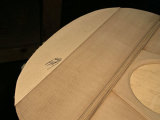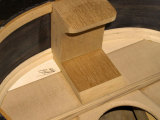The ultimate solution for the rising neck is simple and absolutely reliable—and it has nothing to do with the neck, everything to do with the soundboard.
The light colored wood in the pictures below is a layer of maple veneer glued cross-grain to the heel area of the soundboard. The structure created by this laminate has vastly more shear rigidity than the soundboard wood itself. This laminate area is far away from the bridge, so it has no effect on the guitar’s sound.
The picture above/right shows the soundboard glued to the sides. The maple reinforcement makes the body edge near the heel very rigid, which prevents edge distortion and distributes the stress from the neck over a broad area of the soundboard. This structure, coupled with the heel block extension under the fingerboard above, is s fail-safe effective way to prevent rising neck.
The alternative strategy used by most builders involves beefing up the cedar cross brace in the lower part of the picture or even installing one or more additional braces. This strategy is hopelessly ineffective; no amount of cross bracing like this can prevent the neck from rising. Without a maple-veneer brace like the one I use, the only real impediment to a rising neck in a conventionally designed guitar body is the edge rigidity created by the soundboard wood itself, which isn’t much.


